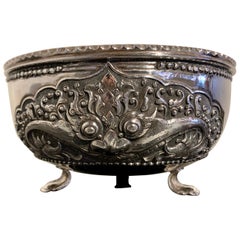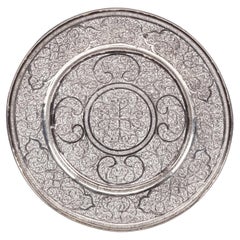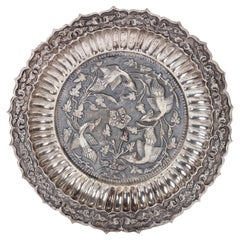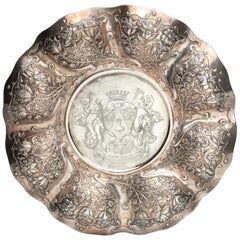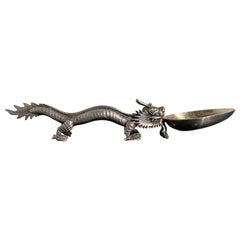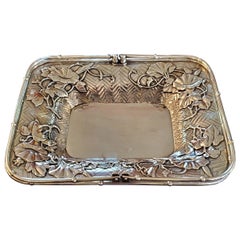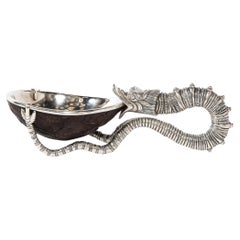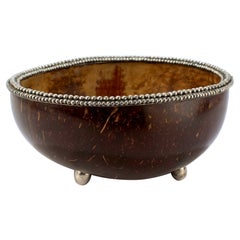Indonesian Sterling Silver
to
4
2
2
1
1
1
1
4
4
3
1
3,335
4,916
2,216
1,732
1,707
4
4
4
Place of Origin: Indonesian
Vintage Yogya Silver Kala Bowl by Tom's Silver, circa 1960's, Indonesia
Located in Austin, TX
A bold and well crafted Indonesian Yogya (Jogja, Djokja) silver bowl by Tom's Silver, Yogyakarta, Java, Indonesia, circa 1960's.
The elegant bowl features a striking design of a Kala face, a protective monster often found above temple doors, and representative of time, death, and rebirth. A pair of makara flank the wide open, smiling mouth. A stylized foliate design surrounds the Kala.
Kala are analogous with the Kirtimukha, or face of glory, originating in India and associated with Shiva. Both beings are devourers of evil and tasked with protection
The bowl features two beaded borders, and a scalloped rim.
The bowl set on three short out-swept feet.
Stamped mark to the underside reading "TOM" "800" "DELUX". TOM stands for Tom's Silver, perhaps the most famous silver workshop in Yogyakarta. 800 is the purity of the silver (80%). DELUX is a common mark on Yogya silver...
Category
1960s Vintage Indonesian Sterling Silver
Materials
Silver
Splendid and Heavy Late 17th Century Dutch-Colonial Silver Filigree Salver
Located in Amsterdam, NL
A splendid and heavy Dutch-colonial silver filigree salver
Indonesia, Batavia (Jakarta) or possibly Padang, West Sumatra, 2nd half 17th century
Diam. 22.9 cm
Weight 551 grams
This filigree-work was probably done by Chinese masters...
Category
17th Century Dutch Colonial Antique Indonesian Sterling Silver
Materials
Silver
Fabulous Indonesian Yogya-Silver Plate
Located in Amsterdam, NL
An Indonesian Yogya-silver plate
Yogyakarta or Kotagede, 1935-1940, marked, (alloy) 800 and maker’s mark PH (Prawirohardjo, act. from 1935)
Diam. 27.2 cm Weight 454 grams
Th...
Category
Early 20th Century Art Deco Indonesian Sterling Silver
Materials
Silver
Dutch Colonial Silver Dish with the Von Pfeffel Coat-of-arms, 17th Century
Located in Amsterdam, NL
An unusual Indonesian lobbed silver dish
Jakarta (Batavia) or Coromandel coast, third quarter 17th century, apparently unmarked
The eight lobbed dish exuberantly decorated with floral motifs, with the middle section replaced, consisting of indistinctly marked German silver from the early 19th century, bearing the coat-of-arms of the Von Pfeffel family.
Diam. 30.5 cm
Weight 461 grams
Note:
Lobbed silver dishes with exuberant floral decorations were characteristic of the decorative arts in the Netherlands in the first half of the 17th century. This style of floral decoration was adopted by silversmiths as well as by furniture makers working on the Coromandel Coast and in Batavia, often by workers who had fled the Coromandel Coast because of war and famine. In Batavia this style was known as “Custwerck” (work from the Bengal coast).
These lobbed dishes are seldom marked. Only after 1667 the use of the town mark became obligatory in Batavia but only for silver made in Batavia not for silver imported in Batavia from other VOC settlements. The engraved coat of arms in the centre is a replacement of the original centre.
The coat of arms can be identified as those of Christian Hubert von Pfeffel (1765- 1834). As a diplomat, statesman, ambassador of Bavaria in London and Saxony and councillor to the King of Bavaria, he was made “Freiherr” in 1828 and since then used this coat of arms. His son Karl Maximilian Friederich Hubert Freiherr von Pfeffel (1811-1890) in 1836 married Karoline Adelheid Pauline von Rottenburg (1805-1872), the natural daughter of Prins Paul von Württemberg (1785-1852) and his mistress Margrethe Porth. Paul was the jounger brother of the King Wilhelm I of Württemberg (1781-1864). The heraldic motto of the von Pfeffels Vur Schande habe den Huot means as much as “Beware of Shame”. Christian Hubert Theodoor Marie Karl von Pfeffel Karl Maximilian’s grandson was the last male in the von Pfeffel line. His daughter, Marie Louise (Paris in 1882 - Cornwall 1944), born and grown-up in France, changed her name in de Pfeffel. She was the great grandmother of Boris Alexander de Pfeffel Johnson, the present British Secretary of State. None of the members of the von Pfeffel family had any direct links with the Dutch East Indies but indirectly by way of the Royal House of Württemberg they did.
Sophia Frederika Mathilda von Württemberg (1818-1877), daughter of Wilhelm I King of Württemberg, in 1839 married Willem III...
Category
Late 17th Century Dutch Colonial Antique Indonesian Sterling Silver
Materials
Silver
Related Items
Chinese Export Silver Dragon Spoon by Wang Hing & Co., Late 19th Century
By Wang Hing & Co.
Located in Austin, TX
A very fine and charming Chinese export silver spoon in the form of a dragon, by Wang Hing & Co., Qing Dynasty, late 19th century, China.
...
Category
1890s Chinese Export Antique Indonesian Sterling Silver
Materials
Silver
$1,200
H 0.88 in W 5 in D 1 in
Japanese Meiji Period Sterling Silver 2 Handled Basket by Katsu Miyamoto
By Miyamoto Shoko 1
Located in Dallas, TX
PRESENTING a GORGEOUS, VERY HIGH QUALITY and EXTREMELY RARE piece of Japanese Meiji Period Sterling Silver 2 Handled Basket by Katsu Miyamoto.
EXQUISITE, EXCEPTIONAL, RARE & IMPORTANT!
This is definitely a Meiji Period piece due to the fact that it is marked with the sterling silver mark “jungin”.
The Meiji period was from 1868 to 1912 and in 1928 a law was introduced in Japan compelling the use of decimal marks for silver.
This pre-dates that decimalization law.
We are of the opinion that it is from circa 1900.
Miyamoto Shoko was founded in 1880 as the first silverware specialty shop. In 1899, Miyamoto Shoko’s silverwares were ordered by the family members of the Emperor of Japan, and to this day, they are making fine and graceful handicrafts with skillful craftsmen.
Loved by numerous customers since the Meiji era, Miyamoto Shoko’s products have also been given to Princess Mako and Princess Kako of Akishino, as well as Princess Aiko Toshinomiya, on their birthdays.
Katsu Miyamoto (宮本勝), in 1880, in order to increase the sales of tobacco and cigarettes to foreigners founded the Moyamoto Shoko company, which produced different silverwares in general and particularly silver cigarette cases. Miyamoto’s first name, Katsu (勝) in some sources is written as “Masaru”, since 勝 kanji can be pronounced in both ways.
This basket is of the HIGHEST QUALITY imaginable!
The top of the basket has the MOST GORGEOUS repousse work of flowers, probably lotus flowers, with leaves and foliage. It has an underlying chevron effect chasing, reflecting parquetry.
The 2 handles are cast in the form of bamboo handles.
The rim of the top likewise is cast as bamboo.
The base is equally stunning in a different way!
It is chased with a chevron effect, like parquetry flooring and the four feet simulate pieces of sliced bamboo with an interlinking gallery of support columns, likewise, simulating bamboo.
The QUALITY of WORKMANSHIP is OUTSTANDING!
The pieces weighs exactly 525 grams.
This piece takes my breath away!
This is one for the SERIOUS COLLECTOR of EXQUISITE AND RARE Japanese silver. You will not find another like it, for sale ANYWHERE ELSE IN THE WORLD …… I know as I have searched!
Provenance: Acquired from a Dallas Private Collector.
Dimensions: 9.6 inches wide, 7.6 inches deep and 2.75 inches tall ( 7.25 inches tall with handles up)
Condition: Very good. It looks like the base 4 legged gallery, has been repaired/re-attached to the base, but otherwise it is excellent and of Museum quality.
The Meiji period (明治時代 Meiji-jidai?), also known as the Meiji era, is a Japanese era which extended from October 23, 1868 through July 30, 1912.[1] This period represents the first half of the Empire of Japan during which Japanese society moved from being an isolated feudal society to its modern form. Fundamental changes affected its social structure, internal politics, economy, military, and foreign relations. The period corresponded with the reign of Emperor Meiji after 1868, and lasted until his death in 1912. It was succeeded by the Taishō period upon the accession of Emperor Taishō to the throne.
Solid silver pieces...
Category
Early 20th Century Meiji Indonesian Sterling Silver
Materials
Sterling Silver
$7,250
H 7.25 in W 9.6 in D 7.6 in
Chinese Export Silver Goblet
Located in London, GB
A Chinese silver goblet profusely decorated with chased, richly defined chrysanthemum against a matte background and is supported by two intertwi...
Category
1890s Chinese Export Antique Indonesian Sterling Silver
Materials
Silver
Chinese Export Silver Jardiniere with Dragons and Figures
By Tuck Chang & Co.
Located in London, GB
A Chinese Export Silver Jardiniere circa 1890, of rectangular form and variously pierced to all four sides. The side with the vacant cartouche has two opposing dragons separated by a...
Category
1890s Chinese Export Antique Indonesian Sterling Silver
Materials
Silver
Chinese Ming Dynasty Silver Nine Phoenix Coronet Crown, 16th/17th Century
Located in Austin, TX
An amazing and rare Chinese silver Nine Phoenix Coronet or Crown, Ming Dynasty (1368 to 1644), late 16th to early 17th century, China.
A delicate and...
Category
Early 17th Century Antique Indonesian Sterling Silver
Materials
Silver, Gold
Antique Dutch Colonial VOC Batavian Tortoise Shell Silver Sirih Casket 1750
Located in Portland, OR
A rare, Dutch Colonial, Batavian (now Jakarta) Dutch East Indies silver and tortoise shell Sirih casket, circa 1750.
The casket was used for storing highly prized betel nut, which was chewed ritually by high ranking Indonesian officials and adopted by settlers from the Dutch East Indies Company...
Category
1750s Dutch Colonial Antique Indonesian Sterling Silver
Materials
Silver
$5,200 Sale Price
20% Off
H 2 in W 4.5 in D 3 in
Art Deco Sterling Silver Dresser Set
By C.&J. Company
Located in Savannah, GA
Sterling silver Chinese export dresser set includes a beveled hand mirror, one hand brush holder, two round dresser containers with scalloped lids, one c...
Category
1930s Art Deco Vintage Indonesian Sterling Silver
Materials
Sterling Silver
Antique Chinese Qing Dynasty Silver Bowl with Dragons and Flower Decoration
By Wang Hing & Co.
Located in Hamilton, Ontario
This antique Chinese silver bowl was made during the Qing dynasty in approximately the year 1900 by the Wang Hing Company and is presumed t...
Category
Late 19th Century Qing Antique Indonesian Sterling Silver
Materials
Silver
$2,950
H 3.25 in Dm 6.25 in
Chinese Export Silver Dragon Motif Knife or Letter Opener
Located in Stamford, CT
Chinese Export silver dinner knife. Overall motif on the handle of dragons with clouds. Single knife could also be used as a letter opener. Stamped markings on the blade.
Category
1880s Chinese Export Antique Indonesian Sterling Silver
Materials
Sterling Silver
Peranakan Chinese Export Silver Tankard with Dragon Handle, 19th Century
Located in Austin, TX
A heavy and well cast Chinese export silver tankard with a dragon handle, made of the Southeast Asian market, mid-late 19th century, China.
The double walled mug or tankard featur...
Category
Late 19th Century Chinese Export Antique Indonesian Sterling Silver
Materials
Silver
Big Antique 17th century key
Located in Chonburi, TH
This Antique 17th-century wrought iron key is a fascinating artifact that transports us back to an era of intricate craftsmanship and timeless elegance. T...
Category
17th Century Antique Indonesian Sterling Silver
Materials
Wrought Iron
Silver Box by Simon Rosenau with a Scene of 5 Men Drinking in the 17th Century
By Simon Rosenau
Located in Delft, NL
Silver Box by Simon Rosenau with a scene of 5 men drinking in the 17th Century
Richly decorated silver box, interior covered with a yellow fabric, raised...
Category
19th Century Antique Indonesian Sterling Silver
Materials
Silver
$1,045
H 1.97 in W 4.14 in D 3.15 in
Previously Available Items
Sterling Silver Mounted Sea Serpent Handled Bowl On Carved Coconut Lilly Pad
Located in New York, NY
This Sterling Silver Bowl with Mounted Sea Serpent Handle Mounted on Carved Coconut Shell W/Lilly Pad & Fish Motif originates from Indonesia during the 20th Century. The piece has re...
Category
20th Century Modern Indonesian Sterling Silver
Materials
Sterling Silver
H 3.5 in W 10 in D 4.5 in
Vintage John Hardy Sterling Silver Mounted Coconut Shell Bowl
By John Hardy
Located in Philadelphia, PA
A wonderful bowl by John Hardy.
Constructed from half of a coconut shell.
Mounted with 3 sterling silver bullet shaped feet and a beaded sterling rim.
(The bowl was likely ...
Category
20th Century Anglo-Indian Indonesian Sterling Silver
Materials
Silver
Recently Viewed
View AllMore Ways To Browse
Towle Chippendale Silver
Towle King Richard Sterling Silver Flatware
Towle Madeira Sterling Silver Flatware
Towle Madeira Sterling Silver
Towle Madeira Sterling
Used Furniture Prince George
Wallace Deco
Wallace Sterling Stradivari
1880 Pressed Glass
Antique Childs Cup
Antique Meat Skewers
Antique Sardine Fork
Antique Serving Utensils
Antique Silver Nutmeg Grater
Antique Silver Shaving
Antique Silver Sheffield Silver Hallmarks
Antique Wine Taster
Art Deco Sterling Silver Drinks Tray
